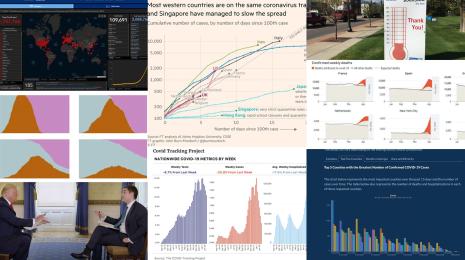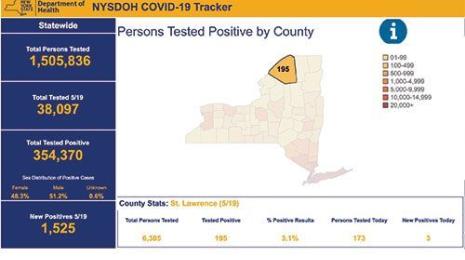Revisiting our 2020 data trends predictions. How the pandemic changed our outlook for the year
Editor's note: This article originally appeared in Forbes.
In early 2020, we published our 2020 Data Trends Report featuring our predictions for the major trends that will shape the future of data and analytics. Little did we know that the world as we knew it would completely change by spring. We recently decided to take a fresh look at these data trends to assess the larger cultural and organizational impacts of Covid-19. What we found was an even greater urgency for data and analytics, to highlight inequities in the world and to help organizations empower collaboration and increase agility.
For this piece, we’ll focus on three trends that have seen rapid acceleration this year—growth in data literacy programs, the emergence of data as a critical resource for advocates highlighting racial inequality, and executive involvement in data culture. For a deeper dive into other topics like artificial intelligence and data storytelling, read the full 2020 Data Trends report.
Data literacy
Early 2020 Prediction: Organizations look to academia as a data literacy incubator
How It’s Evolved: Data literacy remains a foundational mission for agile businesses
Earlier this year, we predicted that data literacy would continue to be high on leaders’ priority lists throughout 2020. Despite a pandemic that led to budget cuts and employees working remotely, data literacy is more important than ever—and leaders are getting creative with their approach to training and development around analytics.
Last year, IDG reported that organizations were making major investments in digital initiatives—an average of $15.3 million in 2019, with 41% of that budget allocated to people and skills. Instead of reducing spending in training and skills in light of COVID-19, leaders are optimizing their training budgets to maximize value from their existing investments.
Before the pandemic, nutritional food company, Huel, prioritized data training and drop-in sessions to upskill employees. This foundation is helping the company adapt to a new business reality. Since many employees understand how to explore data and turn it into insights, they can act with greater speed and clarity on decisions around marketing spend and distribution effectiveness.
In this new world, we’ll see virtual data communities emerge as the preferred method of regular communication among analysts, business users, and line of business leaders. Organizations that already had virtual communities will see them grow as workers need a place to offer inspiration, ask questions, and share best practices in a new remote world. This will set the foundation for more expansive in-person and online training programs in the future.
Data equity
Early 2020 Prediction: Transparency around workplace data leads to equity and organizational success
How It’s Evolved: Data sheds light on inequality and areas where progress is needed
Previously, we discussed data as a tool instrumental in dismantling inequities in the workplace—but even more, we are seeing data being used to shine a light on inequities in the world at large in 2020. The novel coronavirus has had a disproportionate impact on communities of color and to understand the breadth of the impact and to spearhead solutions, we need data. Data from Kaiser Family Foundation shows that as of August 4, the COVID-19 related death rate among Black people was over twice as high as the rate for White people. People from Latinx communities are also seeing higher rates of infection and hospitalization.
Data can be a key tool in building awareness and inspiring action in the fight against inequality. Headwaters Economics, an independent, nonprofit research group, developed a series of data visualizations that show Census response rates for four minority groups: Black, Asian, Hispanic and Latino, and Native American. The decennial Census determines how much federal funding flows into communities and influences decisions about schools, health clinics, and development programs—but Covid-19 is affecting response rates due to health risks, unemployment, and limited door-to-door outreach.

Headwaters pulled in data on Census self-reporting from the U.S. Census Bureau (updated daily), and overlaid it with demographic data on the racial and ethnic makeup of communities across the U.S. Explore the full visualization.
Patty Hernandez Gude, associate director at Headwaters Economics noted: “All of this adds up to a situation where communities of color stand to be represented even less in the 2020 Census than they have been historically. This would be a monumental step backwards.”
Headwaters is working to get these visualizations into the hands of advocates and nonprofits to improve Census response rates. Working with limited resources, these visualizations help them quickly identify how to make the largest impact. “Hopefully the data can serve a purpose and be used to more effectively direct energy and resources in this critical period of time when it can really make a difference,” shared Gude.
Data culture
Early 2020 Prediction: Data strategy stretches across the C-suite
How It’s Evolved: Executives extend data-driven decision making to frontline workers
Digital transformation efforts, particularly in the realm of data and analytics, were once the sole responsibility of the Chief Data Officer. But that paradigm is changing, especially in light of Covid-19, as data and analytics is more tightly woven into business goals.
All executives—not just analytics leaders—at the C-level and VP-level are committing to treat data and analytics as a shared responsibility, and functional leaders are expected to empower their employees with the data and the skills they need to do their jobs. McKinsey recently shared six key lessons that have emerged from crisis-response efforts. One of these was the need for frontline teams to have full decision-making rights.
Chemical and consumer goods company, Henkel Laundry and Home Care leverages self-service analytics in their operations and supply chain. Henkel’s frontline workers—ranging from analysts to global managers to factory line operators—all have access to data to track major KPIs like energy efficiency in factories. When some managers had to shift to remote work, the team moved all major KPIs into online dashboards, so they can conduct operations planning and track the availability of personal protective equipment (PPE) in facilities in order to keep employees safe. Dr. Johannes Holtbruegge, Senior Manager of Transformation at Henkel, noted that the ability to track metrics at a local, regional, and global level creates strong alignment between disciplines and increases agility. All these developments are embedded in a long-term digitalization strategy of the company.
Organizations get more value out of analytics when they bring in the people who know the data best—the people that make and execute decisions based on business goals. When these people have the data they need, along with the necessary skills to interpret and act on the data, organizations build a strong data culture and as a result, stronger networks of teams.
So, what's next?
If we’ve learned anything during this new normal, it’s that predicting what’s next can be incredibly difficult. But we know that the one constant, reliable way forward is with data.
Data is playing an important role in identifying ways we can improve our communities, our businesses, and our world. Organizations using trusted data are well-positioned for navigating through change and setting themselves up for success in the future. Data empowers people to make better decisions, faster, and that has been one of the main differentiators we’ve seen in organizations that are surviving and even finding new and innovative ways of getting work done during this pandemic.
Data will continue to be an even more important component to finding stability and growth, especially as more operations and services move into the digital space. The potential impact of that data will only get stronger as increased automation, AI, and forecasting models help us better predict and prepare for what’s ahead. Even in a crisis, those who have taken the initiative to shift to a digital-first mindset, driven by data, are better prepared to handle whatever comes next.
Storie correlate
Subscribe to our blog
Ricevi via e-mail gli aggiornamenti di Tableau.








